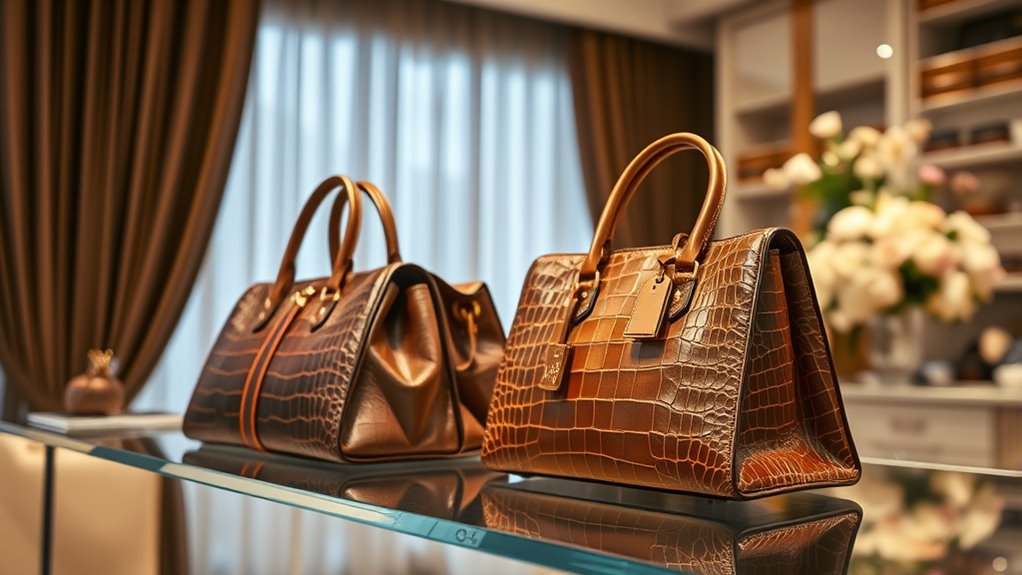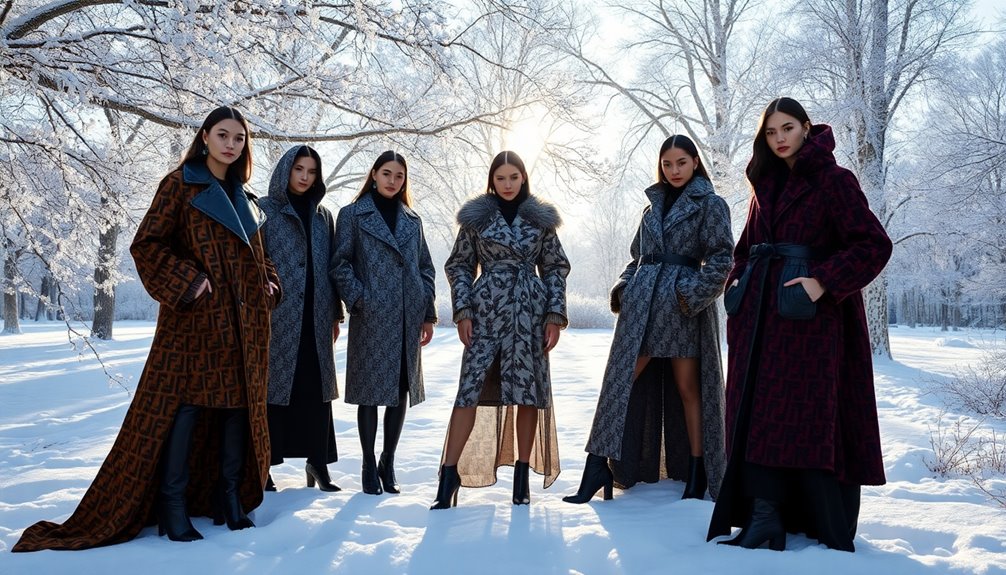Luxury brands set their high prices by carefully controlling their supply chains, working with exclusive suppliers to guarantee quality and rarity. They also leverage their rich heritage and cultural significance, creating a strong emotional connection with buyers. These brands craft an image of exclusivity and status that extends beyond the products themselves. This strategic combination of tradition, craftsmanship, and controlled availability justifies their astronomical prices. Keep exploring to discover how these factors work together to influence luxury pricing strategies.
Key Takeaways
- Luxury brands justify high prices through control of supply chains, exclusivity, and premium sourcing standards.
- Heritage, craftsmanship, and cultural significance add emotional value that elevates perceived worth.
- Limited editions and small batch production increase costs and reinforce exclusivity, raising prices.
- Consumers buy luxury items as symbols of status, heritage, and unique storytelling, justifying premium pricing.
- Strategic pricing leverages brand history, quality, and exclusivity to position products as desirable luxury symbols.

Have you ever wondered what justifies the high prices of luxury fashion brands? It’s tempting to think it’s all about exclusive designs or flashy logos, but the truth runs deeper. Luxury brands carefully craft their pricing strategies around a complex interplay of factors like their supply chain and brand heritage. These elements aren’t just marketing jargon—they’re the backbone of why their products command such premium prices.
Luxury pricing is driven by supply chain control and rich brand heritage, not just design or logos.
When you look at a luxury item, you might assume it’s just about the quality of the fabric or the craftsmanship. While those details matter, the supply chain behind these products is equally significant. Unlike mass-market brands that might source materials from the cheapest suppliers, luxury brands prioritize control and exclusivity. They often work directly with high-quality suppliers, ensuring every component meets their exacting standards. This meticulous approach not only guarantees superior product quality but also increases production costs. Limited editions and small batch runs make the supply chain even more intricate, pushing costs higher and reinforcing the brand’s exclusivity. All these factors elevate the price, as luxury brands accept higher production costs in exchange for maintaining their image of rarity and excellence.
But supply chain alone doesn’t explain the entire story. Your perception of a luxury brand’s value is heavily influenced by its heritage. When you buy a Louis Vuitton bag or a Rolex watch, you’re not just paying for the item itself—you’re investing in centuries of tradition, craftsmanship, and cultural significance. Brand heritage creates a story that resonates emotionally with customers. It’s about the legacy of artisanship, the history of the brand, and the association with a luxurious lifestyle. This story justifies the premium price because it’s perceived as more than just a product; it’s a piece of history and identity. Consumers are willing to pay more because they believe they’re purchasing a symbol of status, craftsmanship, and timeless appeal. Additionally, the controlled supply chain ensures that these products remain exclusive and desirable, further elevating their perceived value.
Luxury brands leverage both their supply chain’s exclusivity and their storied heritage to set prices that seem astronomical to many. They understand that their customers aren’t just buying a product—they’re buying into an experience, a legacy, and a promise of uniqueness. This combination of factors makes their pricing not just about covering costs but about positioning their products as rare, desirable, and worth the investment. Ultimately, it’s a strategic dance—balancing history, quality, and exclusivity—that justifies those sky-high prices you see on luxury shelves.
Frequently Asked Questions
How Do Luxury Brands Determine Their Pricing Strategies?
You might wonder how luxury brands set their pricing strategies. They analyze market segmentation to target specific customer groups, ensuring their prices reflect exclusivity. They also use pricing psychology, setting high prices to enhance perceived value and status. By combining these tactics, they create an aura of luxury, making their products desirable and justifying the premium costs. This approach helps them maintain brand prestige and maximize profits.
What Role Does Brand Heritage Play in Pricing?
You see, brand heritage influences your perception of luxury pricing by shaping brand storytelling. When a brand highlights its history and craftsmanship, it enhances the exclusivity perception, making products feel more valuable. This storytelling creates a sense of tradition and prestige, allowing you to justify higher prices. fundamentally, your appreciation for a brand’s heritage reinforces its premium status, encouraging you to invest in its products because they symbolize legacy and exclusivity.
How Do Limited Editions Affect Product Prices?
Limited editions boost product prices by leveraging scarcity marketing, making them more exclusive and desirable. When you see a limited edition, you realize it’s rare, which increases its perceived value. Luxury brands use this strategy to create urgency and desirability. As a result, you’re willing to pay a premium for these exclusive pieces, knowing their limited nature enhances their prestige and desirability, driving up the price considerably.
Are Luxury Prices Influenced by Geopolitical Factors?
You might wonder if luxury prices are affected by geopolitical risks and trade tariffs. The answer is yes; these factors can influence costs for luxury brands. When geopolitical tensions rise or trade tariffs increase, brands face higher production and shipping expenses. To maintain profit margins, they often pass these costs onto consumers, leading to higher prices. So, geopolitical factors directly impact luxury pricing strategies in today’s interconnected global economy.
How Do Resale Markets Impact Luxury Pricing?
Oh, the resale market—because who doesn’t want to pay double for that vintage designer bag? You see, it impacts luxury pricing by creating a bustling secondhand market where authenticity verification is essential. When items resell at high prices, luxury brands often keep prices lofty to maintain exclusivity, knowing that the secondhand market fuels demand. So, your obsession with a bargain could actually be strengthening the luxury brand’s eye-watering prices.
Conclusion
You see how luxury brands craft their prices through exclusivity, craftsmanship, and branding. You recognize their strategy to elevate status, justify costs, and create desire. You understand that pricing isn’t just about numbers—it’s about perception, prestige, and power. So, when you encounter these prices, remember: it’s not just a product, but a symbol of luxury, a statement of identity, and a reflection of their mastery in the art of desire.









